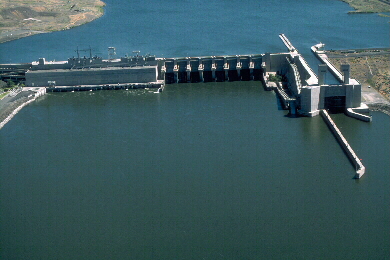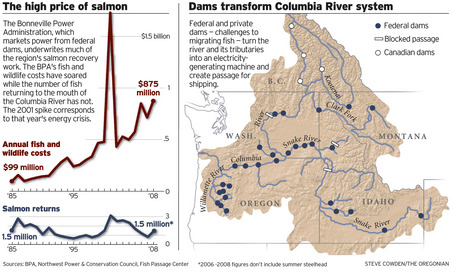forum
library
tutorial
contact

Obama Decision Protects NW Salmon
by Steve WrightSan Francisco Chronicle, September 21, 2009
|
the film forum library tutorial contact |

|
Obama Decision Protects NW Salmonby Steve WrightSan Francisco Chronicle, September 21, 2009 |
 We're seeing encouraging signs for Northwest salmon this year. More than 700 Snake River sockeye have returned to Idaho - the most since we began counting in the 1950s and up from just one in 1992. Snake River fall chinook are expected back in numbers not seen for decades.
We're seeing encouraging signs for Northwest salmon this year. More than 700 Snake River sockeye have returned to Idaho - the most since we began counting in the 1950s and up from just one in 1992. Snake River fall chinook are expected back in numbers not seen for decades.
This is a more promising picture of federally protected salmon in the Northwest's Columbia and Snake rivers than Chronicle readers got in an Aug. 16 editorial calling for breaching hydroelectric dams to save these salmon. The true picture is one of regional collaboration that has helped put these fish on the path to a better future.
The Obama administration last week supported that commitment by strengthening a 2008 blueprint - called a biological opinion - for operating hydroelectric dams without jeopardizing Columbia River salmon. It includes clear standards to ensure more fish pass safely through the dams.
Following intense scientific review, the administration added a plan full of contingency measures as precautions against uncertainties such as climate change.
This is important for the whole West Coast, where fishing fleets share salmon runs from different rivers. Northwest dams have also been a major contributor to California's own energy portfolio, and, in times such as during the West Coast energy crisis, have literally helped the state keep its lights on.
 The administration added specific measures to quickly respond to unexpected salmon declines, including further examination of breaching dams, but only as an option of last resort.
The administration added specific measures to quickly respond to unexpected salmon declines, including further examination of breaching dams, but only as an option of last resort.
The strengthened biological opinion evolved in the Pacific Northwest. It's historic not just because of how far it goes for salmon, but because states and tribes that fought earlier biological opinions helped develop this one - and stand behind it. Washington Gov. Chris Gregoire wrote earlier this year, "The federal government's commitment to continued collaboration and partnership during the BiOp's implementation is a sea change for the region."
Good ocean conditions deserve plenty of credit for this year's surging runs. The assist from the ocean was backed up by hundreds of actions funded by electric ratepayers throughout the region to repair damaged spawning habitat, aid fish survival through hydroelectric dams and fine-tune harvests so fish have the best chance to rebuild their numbers.
The biological opinion recognizes that the challenge of climate change raises the stakes both for salmon and for us. Four dams on the Lower Snake River, which some want breached, generate two coal plants' worth of power without a puff of greenhouse gas. Hundreds of megawatts of this clean power flow south to help California meet its aggressive climate goals.
Saving salmon requires a plan based on sound science, with the commitment and political will to implement it. The Pacific Northwest is fortunate to have both, and the results benefit California as well.
Related Pages:
Electricity Costs and Salmon: Finding the Balance Stephen Wright testimony to House Committee on Resources, 7/7/6
learn more on topics covered in the film
see the video
read the script
learn the songs
discussion forum
